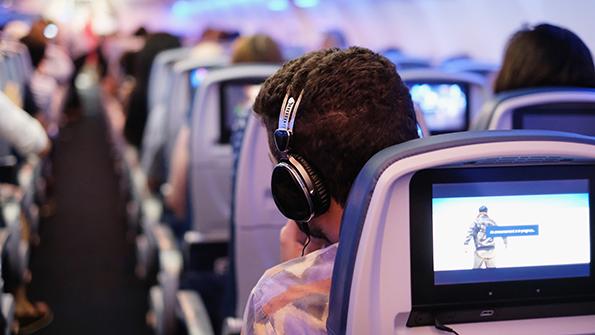新型コロナウィルスが機内インターネットシステム業界に与える試練

機内インターネットおよびエンターテインメントシステム (IFC/IFE:In-Flight Connectivity and Entertainment) 業界が、コロナ危機以前の業績に復帰するには数年を要する見込みであることが、最近の調査で明らかになった。この業界もまた、コロナ危機による民間航空業界の落ち込みに追随したわけだが、アナリストや業界首脳陣は明るい未来も見えていると語る。
Northern Sky Research社の新しいレポートによれば、2029年にかけてのIFCによる収益は、コロナ危機の影響を加味しても370億ドルに迫ると予想しており、これは同期間において毎年9.8%の成長が見込まれることを示している。
とはいえ、事態が改善する前に一旦悪化するだろう。同社も「マーケットではもうしばらく困難な状況が続くだろう」と語っており、2022年以前の改善は考えにくいと認めている。レポートでは「パンデミックの結果として、航空会社における機材の地上保管や経済的圧力、メーカーの生産調整、景気後退、旅行の敬遠といった形で現われるだろう」としている。
最近の四半期報告の中でも、IFC/IFE業界の話題は繰り返された。Thales社の社長兼CEO・Patrice Caine氏は「これは航空会社に関連する事業だ」「よって、今回の航空危機からも大きな影響を受ける」と語っている。
Thales社は幅広い事業を手がけるメーカーであるため、このような危機における対応力は高い。同社のIFE事業の2019年売上は8億ユーロ(8.78億ドル)で、売上全体の11%を占めていた。しかし、2020年の第1四半期にはIFE事業を手がける航空宇宙部門が最も大きな打撃を受けた部門となった。もちろん、航空会社の減便やメーカーの生産量削減が原因だ。
Caine氏は4月28日、投資家やアナリストに対する説明会で「これは短期的には深刻な問題だ」と話している。
競合他社はさらに厳しい状況にさらされている。Gogo社は第1四半期に8,480万ドルの純損失を計上した。この中には長期資産の減損分として4,640万ドル、そして四半期中に追加された信用損失引当金として680万ドルが含まれており、この四半期の損失は前年比で4倍に達した。
さらに悲劇的なのは、同社はここ数年、買い手を探していたような状態にあったにも関わらず、第1四半期の開始時点では輝かしい未来が見えていたことだ。Gogo社の社長兼CEO・Oakleigh Thorne氏は四半期報告の冒頭で「今の状況をCharles Dickensの小説風に言えば、第1四半期はまるで2つの四半期の物語だった。1月と2月は絶頂期だったと思ったら、3月は最悪に近い状況になった」と話している。
そして不運にも、4月の業績は3月よりも悪化したと同氏は続けた。これは航空機の運行数が前年比で95%減となり、世界で193社ある航空会社のうち105社が完全に運航を停止、ビジネス機の運航も80%減となったタイミングだ。同社の5,700ある顧客アカウントのうち約30%がIFCプロバイダーに対するコスト削減に踏み切った。この中には940件のアカウント休止、750件のより安価なプランへの変更が含まれている。
同社は1年前に大規模なリストラをしたばかりだが、財務状況を改善すべくさらなる対応を進めている。5月4日付で同社の本社および3つ全ての事業部において約600名(従業員総数の約54%)を一時帰休とした。
また同社は、コロナウィルス支援・救済・経済保障法(CARES法)に基づき8,100万ドルの助成金と1.5億ドルの融資を申請した。もしこれが認められた場合、「救済の条件に基づき、先日発表した減給や一時帰休措置は見直される」としている。現在、全社員が減給となっており、CEOおよび取締役会メンバーは30%、その他の経営幹部も20%の報酬が削減されている。
5月11日に、同社経営陣は衛星通信事業者や顧客と進めている契約条件の見直し交渉について概要を説明した。同社は機材への機器搭載作業(特に、以前のビジネスモデルに基づく、多額の補助金をGogo社が支払う案件)を延期している。経営の安定を優先するため、原則として年内の搭載作業は行わない方針だ。他のコストカットとしては、設備投資の見送り、マーケティングや出張といった不急の支出の削減が挙げられる。
これらのコスト削減により、2021年末にかけて1.7億ドルの現金を確保できる見込みだとThorne氏は話している。しかし、5月12日付のS&PグローバルレーティングではGogo社の流動性リスクが依然として高いことから、再びネガティブな格付けを行った。S&Pグローバルレーティングによれば、Gogo社は4月に2.11億ドル保有していた現金のうち、1億ドルは来年末までに消費されるという。
S&P社のクレジットアナリストは「ほぼ全ての民間航空が世界規模でストップしている現状に、Gogo社は数ヶ月なら耐えられると思われるが、長期的な見通しはこの状況が続く期間と回復ペースに左右される…そして、それらは現時点では極めて不明確だ」と話している。
IFC/IFE業界はすでに多くの課題に直面していたが、その中でも今回の落ち込みは最悪のものとなるだろう。航空宇宙・防衛分野全体において、流動性は最大の懸案事項だが、その中でもIFC/IFE業界には確立されたビジネスモデルが存在しないことが拍車をかけている。
「民間機用のブロードバンドIFCが魅力的な成長産業であることには、誰もが同意している」とThorne氏は力説する。また、「顧客による採用例も急増しており、メーカーや航空会社も将来の機内ブロードバンドシステムの進化に備え、これまで以上のアプリケーションを整備する体制作りを進めている。しかし、業界内ではまだ持続可能なビジネスモデルは確立されていない」とも語っている。
これらを踏まえても、同氏やNorthern Sky社はポジティブな見通しを崩していない。Northern Sky社のアドバイザーは「新型コロナウィルスにより、IFC事業は大きく揺れるフライトになってしまったので、マーケットの乱気流が収まるまではシートベルトを着用しておく必要がある」「ただし、あくまで揺れるフライトに過ぎず、マーケットが墜落して業界が再起不能に陥るようなものではない」と語った。
以上は、Michael Brunoが Aviation Week & Space Technologyいた記事です。 Aviation Week & Space Technology は、豊富な経験と人脈を持った専門家により、最新トレンドや最適な状況判断、ポリシー・要求仕様・予算に関する充実した情報を継続的にお届けします。 Aviation Week & Space Technology をもっと知りたい場合、こちらをクリックして下さい。
The inflight connectivity and entertainment (IFC/IFE) sector could take years to return to pre-COVID-19 business levels, according to a new analysis. But while the sector has followed commercial and business aviation into a deep rut, analysts and executives say they can see sunnier days ahead.
A new report from Northern Sky Research sees almost $37 billion in cumulative IFC revenue through 2029, despite a near-term plunge due to the novel coronavirus. Overall, the sector should see a compound annual growth rate of 9.8% in the period.
Still, business probably will get worse before it gets better. “Market difficulties are likely to remain for an extended period” and not abate before 2022, Northern Sky acknowledges. “This is likely to occur as pandemic progression results in continued grounded aircraft and financial pressures on airlines, OEMs ramping down aircraft production rates, economic slowdown scenarios, and possible flying hassles and psychological resistance deterring travelers.”
IFC and IFE providers echoed as much in recent quarterly teleconferences. “It’s an airline-related business,” says Thales Chairman and CEO Patrice Caine, and “will be affected as well by this aeronautical crisis.”
Thales is a multi-industrial provider, so it is better suited to weather the downturn. IFE was an €800 million ($878 million) business in 2019, 11% of their sales. But in the first quarter of 2020, the Thales aerospace segment that houses IFE was the hardest hit of the French company’s divisions, due to the drop in both airline activity and production cuts by aircraft OEMs.
“The impact will be very significant, for sure, in the short run,” Caine told investors and analysts April 28.
Competitors are having a more difficult time. Gogo reported a net loss of $84.8 million for the first quarter ended March 31, which includes charges of $46.4 million related to the impairment of certain long-lived assets and $6.8 million in additional credit loss reserves taken during the quarter. The quarterly loss was fourfold compared with a year before.
Tragically, the embattled company—which in recent years considered looking for a buyer—was expecting a bright year at the start of the last quarter. “I am going to steal a little Charles Dickens to put the quarter in perspective, and that is that the first quarter was definitely a tale of two quarters,” Gogo CEO and President Oakleigh Thorne said at the start of his quarterly report. “It was the best of times in January and February and close to the worst of times in March.”
Unfortunately, April business results were even worse than in March, he continued. That was when commercial air traffic dropped 95% from a year before, and 105 of 193 airlines globally were not flying at all. Business aviation also was down 80%. Roughly 30% of Gogo’s 5,700 business jet air-to-ground customer accounts cut their spending with the IFC provider, including 940 account suspensions and more than 750 service plan downgrades.
The company—which a year ago concluded a major restructuring—is undertaking another round of dramatic changes to bolster its finances. Gogo furloughed 54% of its workforce effective May 4, affecting around 600 employees across all three of Gogo’s business segments, as well as at its headquarters.
The company applied for an $81 million grant and a $150 million loan under the recently enacted U.S. Coronavirus Aid, Relief, and Economic Security (CARES) Act. If it receives funding, “it will modify the announced personnel actions to comply with the terms of that assistance.” Compensation was cut for everyone else, including 30% for the CEO and directors on the board and 20% for the rest of executive leadership.
On May 11, executives outlined ongoing negotiations with satellite suppliers and customers to redo contract terms. They also are delaying aircraft equipment installations at airlines, especially those tied to older deals where Gogo “heavily” subsidized equipment under a previous business model. To play it safe, executives now are planning on practically no more installations the rest of this year. Other cutbacks include deferring capital equipment purchases and reducing spending on marketing, travel and nonessentials.
Thorne said the cost savings could save Gogo up to $170 million in cash through the end of 2021. But S&P Global Ratings on May 12 reaffirmed its negative credit watch on Gogo, as its liquidity will remain under pressure. The credit rating agency said by the end of next year Gogo will have burned $100 million of what was a $211 million cash pile at the start of April.
“We believe the company could continue to withstand a near-full, global, commercial ground-stop for a few months, but the long-term viability of the business depends on the duration passenger volumes will be near zero and the length and pace of the recovery—which is highly uncertain at this point,” S&P credit analysts say.
The current rout likely marks the darkest chapter in the IFC/IFE sector, which already was facing challenges. Liquidity concerns are paramount across the entire aerospace and defense sector, but in IFC/IFE it is compounded by a lack of provable business models.
“Everyone agrees that broadband commercial aviation IFC is an attractive growth industry,” Thorne asserts. “Passenger adoption is growing quickly, and OEMs and airlines are poised to drive more operational applications as the quality of inflight broadband grows in the future. But no player in the industry has yet built a sustainable business.”
Still, he and Northern Sky are adopting a positive outlook. “COVID-19 is making IFC a bumpy flight, so IFC players need to fasten their seat belts until the market turbulence has subsided,” Northern Sky advisors say. “But it is just that—a bumpy flight, not a market crash that will stop the industry in its tracks.”